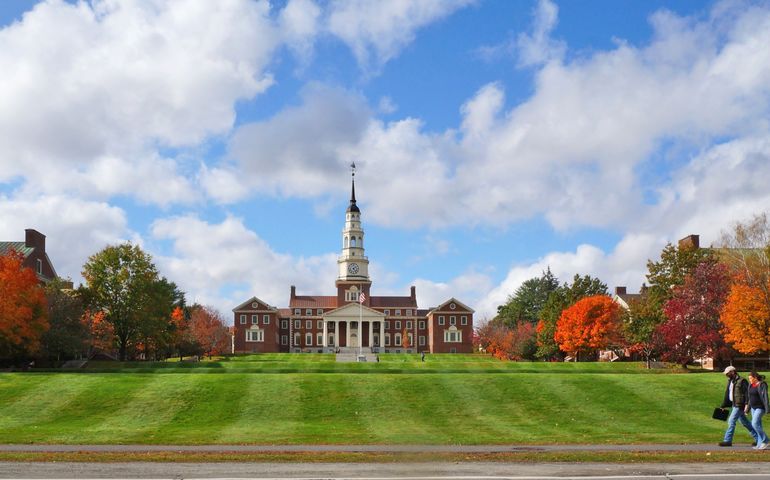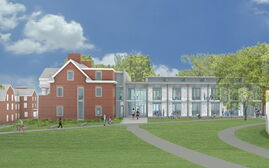
Colby operations, development have $1.5B impact on Maine, study says
 Photo / Maureen Milliken
Colby College in Waterville has spurred $1.5 billion in economic output statewide in the past five years, a study initiated by the college has found.
Photo / Maureen Milliken
Colby College in Waterville has spurred $1.5 billion in economic output statewide in the past five years, a study initiated by the college has found.
Colby College, behind an on-campus and downtown Waterville development boom over the last five years, has had a $1.5 billion economic impact on Maine, a study initiated by the college found.
Some $1.1 billion of that output was in the greater Waterville region over the five years the study covered. The numbers include Colby's operations, capital investments and visitor and student spending between fiscal years 2014 and 2018.

Colby invested more than $143 million in capital improvements on campus in those five years, as well as $1.9 million for the acquisition,and $31.1 million on renovating downtown Waterville buildings, according to the study.
The college knew anecdotally it was having an impact, particularly in its partnership with Waterville on downtown development, but wanted the full picture, Colby President David Greene told Mainebiz Monday.
"When I came to Colby five years ago we began to put a plan in place in the very beginning that was designed both to invest in Colby and the local area," Greene said. There were obvious synergies between Colby and the community, and if the investments focused on both, "the city would be stronger, Colby would be stronger, Central Maine would be more vital if we did that kind of work."
He said while the college felt "we were truly better together with that kind of investment," they wanted to back knowledge up with numbers.
"It was important for us to understand, since we were moving in that direction, were we having an impact? Were we making a difference or not? So this was an honest look at whether or not we were having that impact."
'Shocking' results
The study concludes that the impact is being felt, both in Waterville and beyond.
"Colby’s investments, and the additional private sector investments they stimulate, are critical to Waterville’s fiscal condition," the study says.
Greene said the outcomes are what they'd hoped for, "But I never imagined it would happen this quickly." He said the results being seen now are what he would've expected in 10 years, not five. "It was shocking to me."
"Waterville experienced a sharp uptick in state-adjusted valuation in 2019, which is based on the 2017 tax year. This is the year that Colby invested over $25 million in renovations to downtown buildings," the study says.
It also cites anecdotal evidence that other developers are investing in Waterville, spurred by Colby's lead, equal to the investment Colby has made.
The study also says Colby is "directly addressing the region’s (and Maine’s) most critical problem — the attraction to the area of talented young workers."
Colby, city officials, and regional business and development officials unveiled the study at a news conference this morning at the Bill & Joan Alfond Main Street Commons, the 100,000-square-foot residence and retail space the college built downtown. It opened in August 2018.
Five years of growth
The study also reported a variety of other findings.
Over the last five years, Colby’s operational spending supported more than $450 million in regional GDP and $860 million in total output in the region, and $1.5 billion total output statewide, a 63% increase in total output since FY14.
The college supported more than 2,500 jobs in the region and $111 million in wages in FY18, which includes all operational and capital expenditures, as well as student and visitor spending in the region.
Colby’s footprint on the economy has grown significantly since FY14 with total supported jobs increasing by 56% and total output growing by 75%. Over the five-year period, Colby supported over $1.1 billion in economic output in the two-county region.
Since FY2014, Colby’s capital investments both on- and off- campus have supported $146 million in total regional GDP, almost $300 million in output and an annual average of 460 jobs between FY14 and FY18. The number of supported jobs peaked in FY18 with Colby’s investments directly and indirectly employing 892 people, in addition to 899 Colby employees.
In 2018 alone, Colby’s presence supported total sales for regional businesses of $305 million, supporting more than 2,500 jobs, $111 million in wages, and generating $8.7 million in income, sales and property tax revenue for state and local governments.
Colby’s operational spending in fiscal year 2018 supported 1,600 jobs, up from 1,224 in FY14, as well as $88 million in wages, $109 million in GDP, and $206 million in economic output for the Kennebec-Somerset counties region.
Over the five-year period from 2014 to 2018, employment at Colby increased by 19%, wages by 24%, total operational spending by 34%, and nearly $176 million was invested in Colby’s on-campus facilities and in downtown Waterville. This far exceeded the rates of growth for both the Somerset-Kennebec region (1% employment growth and 12% wage growth) and the state as a whole (4% employment growth and 17% wage growth). Over this same period, Colby supported almost $560 million in gross domestic product (in 2019 dollars).
Colby has supported the generation of almost $34 million in local and state tax revenues (income, sales, and property tax) between FY14 and FY18. Property tax asssement in 2018 was $91.6 milion, up 411% from 2014.
Colby has contributed $1.7 million directly to, or for the benefit of, the city of Waterville in the five-year period, not including taxes.
In fiscal year 2018, Colby spent more than $58 million in purchases from 1,000 vendors headquartered in Maine and representing every Maine county.
In fiscal year 2018 an estimated 34,500 overnight visitors came to the Waterville area from outside the region directly because of Colby, spending an estimated $5.1 million in the area; visitors spent $23.6 million between FY14 and FY18.
Takeaways and surprises
The report was compiled by Ryan Wallace, director of the University of Southern Maine Center for Business and Economic Research; Michael LeVert, principal at Stepwise Data Research; and Chuck Lawton, an economist at Tufts University Fletcher School of Business.
"We wanted it to be done carefully, a lot of these reports aren't the most sophisticated analysis, they just want to tell a good story," Greene said.
The college "wanted to do this in the way were we had a transparent process were we made it very clear about the kind of data we were using and make it a clear substantive study," that was independent of the college.
Greene said the results also support Colby's more specific missions — for instance, supporting local businesses and the local food economy.
Rather than purchase from a strictly financial aspect, the college asks "how can we help local companies and how can we help Maine businesses?"
"We buy food from local farms to support local farms," he said. "Vehicles are bought at local dealers, printing is done by a Waterville printer."
He said the focus on spending in Maine is a departure from the past. "It's much more of a priority for us than it has ever been."
Greene also said he hopes a major impact of the study will be that Colby's success becomes a model for other colleges and universities.
The study made clear to him how much Maine needs growth industries, he said. "Colby is growing quickly, and having a huge impact on local area. What if that happened throughout Maine?"
He said education itself, driven by its connection to startups and communities, can be a much larger economic driver across Maine.
He said part of the genesis of the report is that "there's not a huge expectation that nonprofits will contribute to their communities in vital ways." But he added, "I wanted Colby to think of itself that way."
Greene grew up in Worcester, Mass., the second-largest city in New England. "I know what we're dealing with in Waterville, and this effort, some of it, was informed by my experience growing up in Worcester," he said. "You had 10 colleges [in Worcester] and the city never seemed to benefit."
While it's unusual for a college to invest in developing a downtown, and work with a city in doing so, Colby's history as part of Waterville made this important, he said.
"We're not alone. Other colleges and universities have the capacity to do this," he said. "The more of that the better, as far as I'm concerned."














0 Comments